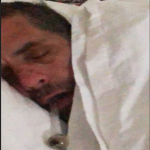hpscp wrote:Can anyone point me to a source that can describe the different terms used in sleep apnea analysis? I'm looking for good techical definitions for the different types of data stored on the smartcards including things like Apnea Hypopnea Index (AHI), APAP, IPAP, EPAP, 90% APAP, Leak Rate (what are the units of a Leak Rate?), what constitutes a large leak, snore index, variable breathing.
Whenever 90% is used in a term, does that always refer to 90% of the time the machine is used, you are above some threshold?
I'm ready to start learning. Just wondering where the best source is to learn all this stuff.
Chris
Perhaps someone has a single source they can point you to. The "Collective Wisdom" lightbulb at the top that Roberto suggested might have some of the definitions/explanations you're looking for.
In the meantime, perhaps this will help (if I got 'em right, and I could be wrong! )
AHI = Apnea/Hypopnea Index. All the apneas and hypopneas you have throughout the sleep session are added together and divided INTO the number of hours you slept. That gives an
average of how many apneas and/or hypopneas you had per hour.
APAP = Auto-titrating cpap or auto-titrating mode of operation. For example, a Respironics REMstar Auto with C-Flex allows these operating modes to be selected in the therapy setup menu:
CPAP - use a single pressure without C-Flex enabled.
CFLE - use a single pressure WITH C-Flex enabled.
APAP - use a range of pressures (auto-titrate) without C-Flex enabled.
AFLE - use a range of pressures (auto-titrate) WITH C-Flex enabled.
The modes of operation in the Respironics BiPAP Auto with Bi-Flex (Bi-Flex works the same as C-Flex):
BPAP - use a higher single pressure for
inhaling (
IPAP pressure) and a lower single pressure for
exhaling (
EPAP pressure)
BFLE - same, but with Bi-Flex enabled.
ABPAP - same as BPAP but with auto-titrating enabled.
AbFLE - same as BFLE but with auto-titrating enabled.
90% = the amount of time spent AT
or BELOW whatever it is reporting. For example, the 90th percentile pressure means the autopap had to use that pressure AND pressures below that pressure, ninety percent of the time during that session.
It does not mean the machine used that one pressure 90% of the time. It may have used a higher pressure for a brief time, and very likely used lower pressures most of the time.
Leak Rate is measured in liters per minute (l/m) with Respironics and Puritan Bennett machines. It's measured in liters per second (l/s) with resmed machines.
Large Leak (reported by a Respironics machine) is when the leak rate gets so high (mask leaks or mouth leaks when not using a FF mask) that the machine can no longer compensate by simply blowing harder to keep the pressure up. When a "LL" happens, an autopap will drop the pressure back down to the minimum pressure set for the range of pressures and will stop recording/reporting "events" (apneas, hypopneas, flow limitations) for as long as the Large Leak is happening. The periods of "LL" will appear as solid black blocks along the top of the Leak graph in Encore Pro.
Snore index ("VS" - Vibratory Snore Index) = the number of "snores" the machine sensed throughout the night, divided into the number of hours of that session. Gives an average of number of snores per hour.
This may not be true for everyone, but for me the VS (vibratory snore index) is meaningless with any REMstar autopap I've used. For whatever the reason (perhaps an inaudible slight flutter in the airway that causes no problem) the REMstar autos have always tallied up many "snores" but the PB 420E auto registered none or almost none. No snore sounds were noted by bed partner. I just ignore the "snore index" when I use the REMstar auto.
A good description of Encore Pro is here:
viewArticle/Encore-Pro-Respironics-CPAP ... Derek.html
Variable Breathing. I've never had a good understanding of this one and have never really paid attention to it. This post about "Variable Breathing" by
StillAnotherGuest is what I'd go with:
viewtopic.php?t=13188
Going beyond the specific things you asked about, here's a link to an interesting post (on page 4) by
ozij regarding interpreting the Encore Pro table chart which states the AHI for each pressure:
ozij's post about "events by pressure".












